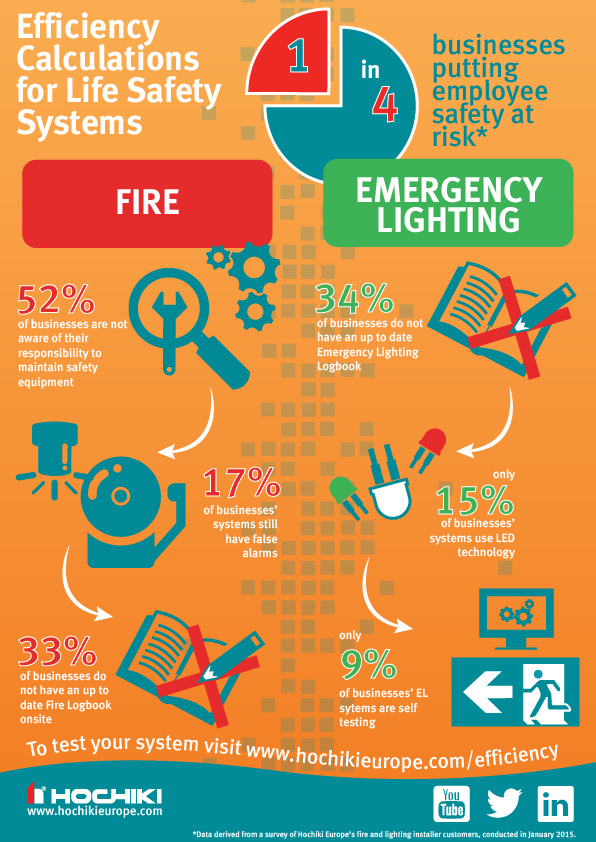
Ensuring efficiency of life safety systems in buildings
Ensuring the safety of employees
David Brown from Hochiki Europe explains why it is important for specifiers to support organisations to optimise the efficiency of their life safety systems
To comply with the Regulatory Reform (Fire Safety) Order 2005, organisations must do more than install the appropriate fire safety and emergency lighting equipment in their buildings. They have to ensure their systems are regularly and correctly maintained, with all performance information recorded in a logbook.
However, according to recent research from Hochiki Europe[1], as much as a quarter of European businesses are failing to keep their life safety technology properly maintained. More than a third are also not accurately monitoring equipment performance in a logbook.
Not only is irregular maintenance of fire safety systems in breach of legislation, it can result in false alarms. Hochiki Europe’s study also found that up to 17 per cent of businesses still suffer from false alarms, causing significant business disruption to building users preventing fire and rescue services from attending genuine alerts. Recent Government statistics[2]show that the UK’s fire and rescue services attended nearly a quarter of a million false alarms over the last two years, caused by faulty fire safety systems. This poses a significant risk to the safety and well-being of building occupants.
With these issues in mind, it is crucial that specifiers support businesses in meeting regulatory requirements and upholding the safety of their building users by helping to optimise the efficiency of their fire safety and emergency lighting equipment. To achieve this goal, there are a number of factors that need to be kept in mind.
Simplifying aftercare
When seeking to maximise efficiency, specifiers need to consider the maintenance and monitoring entailed by their shortlisted fire safety and emergency lighting systems.
Not all technologies require the same level of care. Some systems will demand additional maintenance and monitoring over their lifetime, compared with alternatives. Others may be vulnerable to unexpected performance issues that can lead to unplanned downtime, as well as repairs. Such extra care will have a negative effect on efficiency for building owners, costing them valuable time and money to maintain systems in optimal condition.
Realistically, specifiers can simplify these operational processes for building owners, and reduce the total cost of ownership (TCO) of fire safety and emergency lighting equipment by recommending solutions that have minimal aftercare needs. Self-testing fire safety and emergency lighting technology, for example, can significantly cut the amount of time building owners spend monitoring their systems. Selecting products with a comprehensive warranty can also help lower the cost of unexpected repairs.
Cutting energy use
In addition to operational efficiency, specifiers should think about addressing the energy efficiency of the emergency lighting systems they install.
Solutions that consume less power can significantly reduce operating costs over their lifetime than alternatives, lowering their TCO. Emergency lighting incorporating low-voltage cabling and LEDs, for example, have been shown to use just five per cent of the energy of standard fluorescent tubes[3]. LED bulbs also need just five per cent of the lamp bulb changes required by traditional luminaires, further streamlining maintenance for building owners.
According to Hochiki Europe’s research, just 15 per cent of European businesses currently have LED systems installed in their buildings, meaning many firms are still not taking advantage of the technology’s energy efficiency benefits.
Getting guidance
There is plenty of support available to specifiers from life safety system manufacturers to help them select the most suitable solutions for the building in question.
Hochiki Europe, for example, has developed an online efficiency calculator to help building owners assess the performance of their existing fire safety and emergency lighting systems. The tool questions users on their building’s existing equipment to provide targeted guidance on upgrading it to improve efficiency and ensure regulatory compliance.
Many manufacturers also provide on-site technical experts, offering tailored guidance to specifiers to help them design the most effective life safety systems for the needs of the building, ensuring they balance both efficiency and occupant safety.
Achieving efficiency
Ensuring fire safety and emergency lighting equipment is correctly and regularly maintained is not just a requirement for compliance with legislation. It is a necessity for helping building owners to maximise efficiency and minimise the operating costs for their development as a whole.
There is no one-size-fits-all solution to the issue of efficiency. However, by taking advantage of the support available from life safety experts, specifiers can ensure they recommend the most appropriate technology for their customer’s needs, helping them save time and money, while also safeguarding the health and well-being of building occupants.
..
[1] Data from a representative sample of European fire and lighting system installers during January 2015
[2] Department for Communities and Local Government:
https://www.gov.uk/government/statistics/fire-statistics-monitor-april-2013-to-march-2014
[3] Based on a maintained system of 100 LED luminaires compared to 100 traditional fluorescent tube light fittings.
More about Hochiki Europe: Introduction Video (in 7 languages) available on the official Hochiki Europe YouTube channel
Latest news

18th December 2024
BMBI: October Merchant sales rally with a +7.3% month-on-month increase
The latest Builders Merchant Building Index (BMBI) report shows builders’ merchants’ value sales in October were up +1.2% compared to the same month last year.
Posted in Articles, Bathrooms & Toilets, Bricks & Blocks, Building Associations & Institutes, Building Industry News, Building Products & Structures, Building Services, Building Systems, Civil Engineering, Cladding, Concrete, Cement, Admixtures, Drainage, Drainage Services, Floors, Garden, Hand Tools, Hard Landscaping & Walkways, Health & Safety, Heating Systems, Controls and Management, Heating, Ventilation and Air Conditioning - HVAC, Information Technology, Interior Design & Construction, Interiors, Landscaping, news, Paints, Paints, Coatings & Finishes, Pipes, Pipes & Fittings, Plant, Equipment and Hire, Plumbing, Power Tools, Publications, Research & Materials Testing, Restoration & Refurbishment, Retrofit & Renovation, Site Preparation, Sustainability & Energy Efficiency, Timber Buildings and Timber Products, Walls, Waste Management & Recycling
18th December 2024
GEZE UK announce Kids' Village charity partnership
Kids’ Village is delighted to have partnered with GEZE UK as their 2025 charity of the year – find out more via the article…
Posted in Access Control & Door Entry Systems, Architectural Ironmongery, Articles, Building Industry Events, Building Industry News, Building Products & Structures, Building Services, Charity work, Doors, Facility Management & Building Services, Health & Safety, Restoration & Refurbishment, Retrofit & Renovation, Security and Fire Protection, Windows
18th December 2024
Encon Achieves 5% Club Silver Membership
The Encon Group, the leading independent distributor of building materials, is pleased to announce that it has been awarded Silver membership of The 5% Club by the 2024/25 Employer Audit Scheme.
Posted in Articles, Awards, Bricks & Blocks, Building Associations & Institutes, Building Industry Events, Building Industry News, Building Products & Structures, Building Regulations & Accreditations, Building Services, Building Systems, Civil Engineering, Cladding, Concrete, Cement, Admixtures, Facades, Hard Landscaping & Walkways, Health & Safety, Insulation, Landscaping, Plant, Equipment and Hire, Recruitment, Restoration & Refurbishment, Retrofit & Renovation, Site Preparation, Training, Walls
18th December 2024
SWA: A focus on Steel Window Association member West Leigh
Located in Charlton, South London, SWA member West Leigh was established during the Blitz, in 1943. During the destruction in London, the company helped in repairing windows and facades that had been damaged by bombings throughout the city.
Posted in Articles, Building Associations & Institutes, Building Industry News, Building Products & Structures, Building Services, Building Systems, Case Studies, Facades, Glass, Glazing, Restoration & Refurbishment, Retrofit & Renovation, Steel and Structural Frames, Walls, Windows
 Sign up:
Sign up: